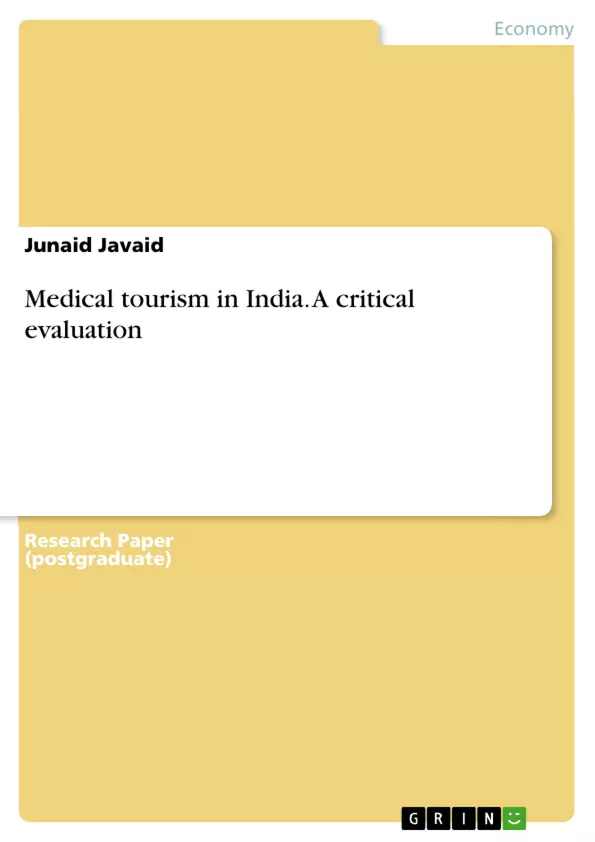This research project examines the phenomenon of medical tourism in India. It contain case studies of three major players of the Indian medical tourism sector. Core aim of this research project is to evaluate the current market situation and the influence of external environmental factor on the Indian medical tourism sector.
Inhaltsverzeichnis (Table of Contents)
- Section 1- Background Context
- 1.1. Background Context
- 1.2. Motivation
- 1.3. Aims & Objectives
- 1.4. Method
- Section 2- Literature Review
- 2.1. What is meant by Medical Tourism?
- 2.2. Opportunities for Medical Tourism Sector in Developing Economies
- 2.2.1. Improving the Image
- 2.2.2. Quality Standards
- 2.2.3. Infrastructure
- 2.2.4. Simplification of Medical & Travel Services
- 2.3. Challenges & Threats for Medical Tourism in Developing Countries
- 2.3.1. Medical Problems
- 2.3.2. Legal Problems
- 2.3.3. Ethical Problems
- 2.4. Indian Medical Tourism Sector
- 2.5. Forms of Medical Tourism Services in India
- 2.6. Current Situation of Indian Medical Tourism Sector
- 2.7. PEST Analysis of Indian Medical Tourism Sector
- 2.7.1. Political Factor
- 2.7.2. Economic Factor
- 2.7.3. Sociological Factor
- 2.7.4. Technological Factor
- Section 3- Case Studies
- 3.1. Case Study on Apollo Hospitals
- 3.2. Case Study on Escorts Heart Institute & Research Centre (EHIRC)
- 3.3. Max Healthcare
- Section 4- Analysis
- 4.1. Analysis
Zielsetzung und Themenschwerpunkte (Objectives and Key Themes)
This research project aims to provide a critical evaluation of the Indian medical tourism sector. It analyzes the current market situation, exploring the influence of external environmental factors on the sector's growth and challenges. The study delves into the opportunities and obstacles for developing countries involved in medical tourism.
- Growth and Challenges of Medical Tourism in Developing Economies
- Opportunities and Threats for the Indian Medical Tourism Sector
- The Influence of Globalization on Healthcare Provision
- Case Studies of Major Players in the Indian Medical Tourism Sector
- The Role of Technology and Infrastructure in Medical Tourism
Zusammenfassung der Kapitel (Chapter Summaries)
Section 1: Background Context provides an overview of the globalization concept and its impact on healthcare provision, highlighting the emergence of medical tourism. It also introduces the research aims and objectives, as well as the methodology used.
Section 2: Literature Review delves into the definition of medical tourism and its opportunities in developing economies. It outlines the key challenges and threats, including medical, legal, and ethical considerations, specific to the developing countries' context. The section then focuses on the Indian medical tourism sector, its current state, and its PEST analysis.
Section 3: Case Studies presents in-depth analyses of three major players in the Indian medical tourism sector: Apollo Hospitals, Escorts Heart Institute & Research Centre (EHIRC), and Max Healthcare. Each case study examines the factors contributing to their success within the sector.
Section 4: Analysis analyzes the information gathered from the case studies, drawing insights into the key success factors and challenges faced by the Indian medical tourism sector.
Schlüsselwörter (Keywords)
Key terms and concepts explored in this research include medical tourism, developing economies, globalization, healthcare provision, PEST analysis, case studies, Apollo Hospitals, Escorts Heart Institute & Research Centre (EHIRC), Max Healthcare, and opportunities and challenges of the Indian medical tourism sector.
- Arbeit zitieren
- Junaid Javaid (Autor:in), 2015, Medical tourism in India. A critical evaluation, München, GRIN Verlag, https://www.grin.com/document/304673



